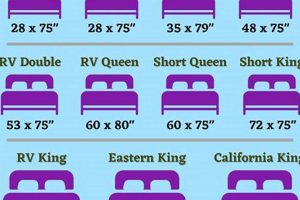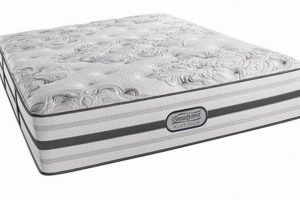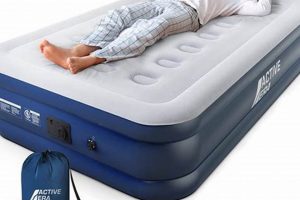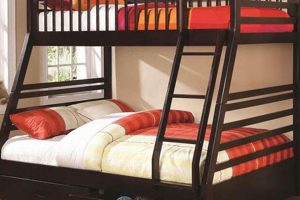A sleeping surface dimensionally larger than a standard twin, but narrower than a full, finds common application in settings requiring more length than width. This bed type typically measures approximately 39 inches wide by 80 inches long. As an example, college dormitories frequently utilize this size to accommodate taller students in a space-efficient manner.
The extended length provides increased comfort for individuals exceeding average height, ensuring adequate legroom and preventing discomfort. Its adoption reflects an understanding of diverse physical needs and the importance of restorative sleep. Historically, institutions such as universities recognized the limitations of standard-sized beds and adapted by implementing this extended configuration to better serve their populations.
Understanding the specific characteristics of this mattress size is crucial when selecting appropriate bedding, frames, and related accessories. The following sections will delve into considerations for choosing the right model, optimal bed frame pairings, and care and maintenance recommendations.
Guidance on Selecting and Utilizing an Extended Twin Mattress
The selection and proper utilization of an extended twin mattress require careful consideration to ensure optimal sleep quality and longevity of the product. The following points provide essential guidance for prospective purchasers and current owners.
Tip 1: Measure Available Space: Prior to purchase, accurately measure the dimensions of the intended room. Account for additional furniture and ensure sufficient space for comfortable movement around the bed.
Tip 2: Consider Sleeper Height: This mattress type is particularly well-suited for individuals exceeding six feet in height. Assess the sleeper’s height to determine if the added length is a necessary feature for comfort.
Tip 3: Evaluate Mattress Firmness: Mattress firmness is a subjective consideration, but different support levels cater to various sleep preferences and body weights. Research different firmness ratings (e.g., plush, medium, firm) to select the most appropriate option.
Tip 4: Research Mattress Materials: Different materials, such as memory foam, innerspring, or latex, offer varying levels of support, temperature regulation, and durability. Examine the properties of each material to determine the best fit.
Tip 5: Select a Compatible Bed Frame: Ensure the chosen bed frame is specifically designed to accommodate this particular mattress size. Using an incompatible frame can lead to inadequate support and premature wear.
Tip 6: Utilize a Mattress Protector: A waterproof and hypoallergenic mattress protector safeguards against spills, stains, and allergens, extending the lifespan and maintaining the hygiene of the mattress.
Tip 7: Rotate the Mattress Regularly: Rotating the mattress every few months helps to distribute wear evenly and prevent sagging, contributing to consistent support and comfort over time.
Tip 8: Check Warranty Information: Before completing a purchase, carefully review the manufacturer’s warranty details, including coverage limitations and claim procedures, to understand protection against potential defects.
Implementing these recommendations enables informed decision-making and promotes a beneficial sleep environment. A properly selected and maintained mattress of this type enhances comfort and promotes restful sleep.
The concluding section will address common misconceptions and provide a comparative analysis relative to other mattress dimensions, reinforcing informed decision-making in the selection process.
1. Dormitory Accommodation
The prevalence of the extended twin mattress within dormitory settings is not arbitrary but reflects specific spatial and demographic considerations inherent to these environments. Standard dormitory rooms often present spatial limitations, while simultaneously accommodating a population frequently comprised of young adults, many of whom exceed average height. This intersection of restricted space and taller individuals necessitates a sleeping solution that maximizes comfort without compromising room functionality. Thus, the extended twin emerges as a logical choice.
- Space Optimization in Shared Rooms
Dormitories commonly house multiple occupants within a single room. The extended twin allows for adequate sleeping space without encroaching excessively on the overall floor area. Compared to a standard double or full-sized bed, its narrower width enables better arrangement of desks, storage units, and other essential furnishings, promoting efficient use of limited space. This optimization is crucial in facilitating a functional and livable shared environment.
- Accommodating Taller Students
A significant portion of the student population requires more length than a standard twin mattress offers. The extra length prevents discomfort caused by constrained legroom, contributing to improved sleep quality. Institutions recognize that providing adequate sleeping arrangements directly impacts student well-being and academic performance. This mattress size represents a practical response to the physical needs of taller individuals within the constraints of dormitory infrastructure.
- Standardization for Efficiency
Implementing a uniform mattress size simplifies logistics for university housing departments. Standardized bedding, including sheets, blankets, and mattress protectors, can be purchased in bulk, reducing costs and streamlining inventory management. Uniformity also facilitates easier room assignments and furniture configurations, contributing to operational efficiency across the entire residential system.
- Durability and Longevity Considerations
Dormitory mattresses are subjected to considerable use and, at times, potential misuse. Selecting mattresses with robust construction and durable materials is paramount. Institutions prioritize mattresses that can withstand heavy use and resist premature wear and tear, ensuring long-term cost-effectiveness and minimizing replacement frequency. Investing in quality construction translates to reduced maintenance and replacement expenses over the lifespan of the mattress.
The adoption of this particular mattress size in dormitory settings, therefore, is not merely a matter of convenience but a calculated decision driven by a confluence of factors: spatial constraints, demographic considerations, operational efficiency, and long-term cost-effectiveness. It exemplifies a pragmatic solution tailored to the unique demands of the dormitory environment.
2. Taller Individuals
The dimensional requirements of taller individuals necessitate specialized sleeping arran
gements to ensure adequate comfort and restorative rest. Standard-sized mattresses often prove insufficient for those exceeding average height, leading to discomfort and disrupted sleep patterns. The extended twin mattress addresses this specific need by providing additional length without the increased width of a full or queen-sized bed.
- Adequate Legroom and Spinal Alignment
The primary benefit of an extended twin for taller individuals is the provision of adequate legroom. Without sufficient length, the sleeper’s feet may hang off the end of the mattress, causing discomfort and disrupting spinal alignment. This prolonged malposition can lead to back pain and other musculoskeletal issues. The extended length allows for full body support, maintaining proper spinal alignment throughout the night.
- Prevention of Sleep Disturbances
Restricted legroom often results in involuntary movements and shifts in body position during sleep as the individual attempts to find a comfortable posture. These movements disrupt sleep cycles, leading to fragmented and less restorative rest. The added length minimizes the need for these adjustments, promoting deeper and more continuous sleep. This reduction in sleep disturbances directly contributes to improved daytime alertness and cognitive function.
- Accommodation in Restricted Spaces
Even when taller individuals require a longer mattress, spatial limitations may prevent the use of larger beds. The extended twin offers a compromise, providing the necessary length while maintaining a narrower width. This is particularly advantageous in smaller bedrooms, dormitories, or shared living spaces where optimizing floor space is crucial. It allows taller individuals to experience enhanced comfort without sacrificing room functionality.
- Psychological Comfort and Sense of Security
Beyond the physical advantages, the appropriately sized mattress contributes to a sense of psychological comfort and security. Knowing that the bed is adequately sized promotes relaxation and reduces anxiety related to inadequate support. This sense of security fosters a more conducive environment for sleep onset and maintenance. The extended twin, therefore, addresses not only the physical needs of taller individuals but also their psychological well-being.
The specific dimensional advantage offered by the extended twin mattress directly addresses the unique needs of taller individuals. By prioritizing adequate legroom, minimizing sleep disturbances, and optimizing spatial considerations, this mattress size promotes improved sleep quality and overall well-being for this demographic. Its strategic design provides a practical and effective solution for those seeking enhanced comfort within potentially limited spaces.
3. Bedding Compatibility
The dimensional specificity of an extended twin mattress directly influences bedding compatibility. Standard twin-sized sheets and blankets are demonstrably insufficient, resulting in inadequate coverage and potential discomfort. The increased length necessitates the acquisition of appropriately sized bedding, designated as “twin XL” or “twin extra long.” Failure to adhere to these dimensional requirements renders the bedding ineffective in providing adequate warmth and comfort. For example, standard twin sheets will not adequately tuck under the mattress, leading to them becoming dislodged during sleep, a situation avoided with correctly sized bedding.
The implications of selecting incompatible bedding extend beyond mere discomfort. Ill-fitting sheets can contribute to premature wear and tear on the mattress itself, as friction increases due to the lack of secure coverage. Furthermore, the aesthetic appeal of the bed is compromised when bedding does not conform to the mattress dimensions. Consider the instance of a college dormitory: consistent use of standard twin sheets on extended twin mattresses would lead to accelerated deterioration of the mattresses and increased operational costs for replacement, highlighting the practical significance of bedding compatibility.
In summary, the accurate selection of bedding compatible with this mattress size is paramount. It is not merely an aesthetic consideration but a functional necessity directly impacting comfort, mattress longevity, and overall cost-effectiveness. Neglecting this dimensional congruence can result in both immediate discomfort and long-term financial implications, underscoring the importance of proper bedding procurement.
4. Space Optimization
The adoption of an extended twin mattress often stems directly from a need for space optimization, particularly in environments with limited square footage. Its dimensions present a strategic compromise: the length accommodates taller individuals, while the narrower width minimizes encroachment on valuable floor space. This configuration is particularly valuable in settings where multiple beds are required within a confined area, such as college dormitories or shared bedrooms. The efficient use of space allows for the incorporation of other essential furniture and facilitates greater ease of movement within the room. A larger mattress, while potentially more comfortable, may compromise these practical considerations.
The relationship between mattress size and available space impacts functionality and organization. In a small bedroom, opting for a mattress beyond the extended twin dimensions may necessitate sacrifices in storage space or desk area, potentially hindering productivity and overall comfort. The extended twin, by contrast, allows for a more balanced distribution of resources within the room. For instance, in a dormitory setting, multiple extended twin mattresses can be arranged to maximize sleeping capacity while still permitting reasonable personal space for each occupant. The selection criteria, therefore, directly involve trade-offs between personal comfort and spatial efficiency.
Understanding the dimensional constraints and optimizing space usage are paramount considerations when choosing a sleeping surface. The extended twin mattress exemplifies a pragmatic solution for situations where space is at a premium and taller individuals must be accommodated. Successfully integrating this mattress size requires careful planning and awareness of its specific dimensional characteristics, but the resulting optimization of available space can significantly enhance the overall functionality and livability of the room.
5. Frame Requirements
The support structure beneath an extended twin mattress is integral to its longevity and the sleeper’s comfort. The dimensions necessitate a frame specifically designed to accommodate its 80-inch length, as standard twin frames are insufficient. Inadequate support can lead to premature mattress sagging, compromised sleep quality, and potential structural damage to the frame itself. Therefore, understanding frame requirements is paramount.
- Dimensional Accuracy
The interior dimensions of the bed frame must precisely match the mattress size. An undersized frame will cause the mattress to compress and deform, while an oversized frame
will result in instability and potential shifting. Accurate measurements are crucial before purchasing a frame. For example, a frame designed for a standard twin (75 inches long) will not adequately support an extended twin mattress, leading to overhang and reduced support at the foot of the bed. - Load-Bearing Capacity
The frame must be capable of supporting the combined weight of the mattress and the sleeper. Insufficient load-bearing capacity can lead to structural failure, potentially resulting in injury. Frame materials and construction directly impact its ability to withstand weight. For instance, a frame constructed from solid hardwood with reinforced joints will provide greater support than a frame made from lightweight metal or particleboard. Consider weight limits specified by the manufacturer.
- Slat Spacing and Support
The spacing between the slats that support the mattress is a critical factor. Excessive spacing can allow the mattress to sag between the slats, reducing support and potentially damaging the mattress core. The material and construction of the slats are also important; wider, thicker slats provide greater support. A frame with closely spaced, solid wood slats is preferable to one with widely spaced, thin metal slats.
- Headboard and Footboard Compatibility
While not directly related to support, the compatibility of the frame with headboards and footboards can impact the overall stability and aesthetic appeal of the bed. Ensure that the frame is designed to accommodate the desired headboard and footboard attachments. Using incompatible attachments can compromise the structural integrity of the frame. For example, attempting to attach a heavy headboard to a frame not designed for it can cause warping or breakage.
Failure to adhere to the specific frame requirements for an extended twin mattress can negate its intended benefits, such as providing adequate support for taller individuals. The frame is not merely an aesthetic element; it is an integral component that directly impacts mattress longevity, sleep quality, and overall safety. Investing in a properly sized and structurally sound frame is essential to maximize the value and utility of the mattress.
Frequently Asked Questions
The following questions address common inquiries and misconceptions surrounding the dimensions, usage, and purchasing considerations for twin extra long mattresses. The information presented aims to provide clarity and facilitate informed decision-making.
Question 1: What distinguishes a twin extra long mattress from a standard twin mattress?
The primary distinction lies in length. A twin extra long mattress measures 80 inches in length, whereas a standard twin mattress measures approximately 75 inches. This additional length caters specifically to taller individuals requiring more legroom.
Question 2: Are standard twin sheets compatible with a twin extra long mattress?
No, standard twin sheets are not adequately sized for a twin extra long mattress. The added length necessitates the use of sheets specifically designated as “twin XL” or “twin extra long” to ensure proper coverage and a secure fit.
Question 3: What types of bed frames are suitable for a twin extra long mattress?
A bed frame specifically designed to accommodate a twin extra long mattress is essential. Standard twin frames are generally too short and will not provide adequate support. Adjustable bed frames, platform beds, and traditional frames are available in the appropriate dimensions.
Question 4: Is a twin extra long mattress suitable for adults or primarily intended for children?
While often used in college dormitories, the mattress is suitable for adults, particularly those exceeding average height. Its dimensions provide ample length for comfortable sleep, regardless of age.
Question 5: What is the typical cost differential between a twin extra long mattress and a standard twin mattress?
The price difference varies depending on the manufacturer and materials used. However, the extended length typically results in a slightly higher cost compared to a standard twin mattress of comparable quality.
Question 6: Where are twin extra long mattresses commonly used outside of college dormitories?
Besides dormitories, these mattresses are found in guest rooms, small apartments, and situations where accommodating taller individuals in a space-efficient manner is prioritized.
In summary, the extended length is the defining characteristic, requiring specialized bedding and frame considerations. This mattress type serves a specific need for taller individuals and space-conscious environments.
The subsequent section will explore alternative mattress sizes and provide a comparative analysis to further inform purchasing decisions.
Conclusion
This exploration has addressed the key characteristics and applications of the twin extra long size mattress. Its dimensional advantage, particularly the extended length, caters specifically to taller individuals and situations demanding spatial efficiency. The importance of compatible bedding and properly sized bed frames has been emphasized, as these factors significantly impact comfort, mattress longevity, and overall user satisfaction. From dormitory settings to compact living spaces, this mattress type serves a defined purpose when standard dimensions prove inadequate.
The selection of a sleeping surface represents a considerable investment in personal well-being. Careful consideration of individual needs, spatial constraints, and the compatibility of ancillary components is paramount. Prospective purchasers are encouraged to thoroughly evaluate their options and prioritize quality and proper support to ensure restful sleep and long-term value. The choice should align with individual requirements to maximize the benefits derived from this specific type of mattress.





![Deals on Twin Mattress Black Friday Sale [Year] | [Brand] Organic & Natural Mattress Buyer’s Guide: Non-Toxic Sleep Solutions Deals on Twin Mattress Black Friday Sale [Year] | [Brand] | Organic & Natural Mattress Buyer’s Guide: Non-Toxic Sleep Solutions](https://mattressworldpa.com/wp-content/uploads/2025/07/th-5066-300x200.jpg)

